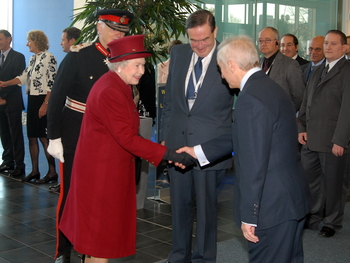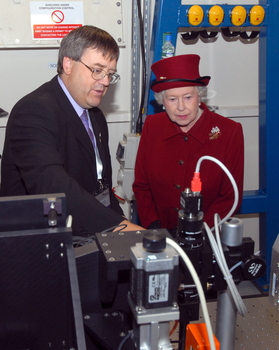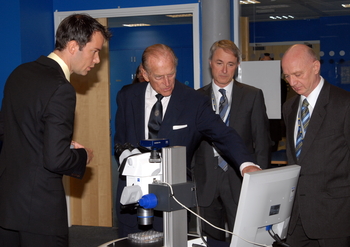Find out more about our ambitious upgrade project, delivering more brightness, more coherence, and greater speed of analysis to UK science. More about Diamond-II
![]()
Find out more about Diamond's response to virus research.
![]()

Her Majesty The Queen, accompanied by His Royal Highness The Duke of Edinburgh, officially opened Diamond Light Source, the UK’s new national synchrotron facility today (Friday 19 October 2007). Diamond is the largest science facility to be built in the UK for 40 years and is set to play a major role in facilitating ground breaking science that is carried out in this country over the coming decades.
The Royal Party toured the synchrotron machine – an incredible feat of science and engineering measuring over half a kilometre in circumference and covering an area over three times the footprint of Buckingham Palace. During the visit, they were shown how the powerful light is produced and exploited, along with the range of science to which Diamond has already started to contribute. Since the first research scientists were welcomed to Diamond in January 2007, a wide variety of experiments have taken place. These include research work that could potentially lead to drugs being available to prevent cancer cells from spreading, studying meteorites to understand the early solar system, examining ways to improve digital data storage through improved magnetic materials, and using the powerful X-rays to investigate fragile ancient parchments.

The Queen and The Duke of Edinburgh were also briefed on future research that is planned at Diamond in 2008, including a vivid example with some suitably royal connections. In the 21st century cutting edge synchrotron technology is helping to conserve the fabric of the legendary Tudor warship, the Mary Rose, which was built over 450 years ago in the reign of her ancestor Henry VIII. The timbers from the Mary Rose collected a lot of sulphur accumulated from micro-organisms while in the ocean sediment before she was raised 25 years ago this month. Scientists are using Diamond's X-rays to investigate the presence of the sulphurous compounds in the salvaged wood, which are thought to be slowly turning into highly corrosive sulphuric acid and eating away at the ship’s timbers – a problem which seems to be exaggerated at points where iron (such as bolts) have been in contact with the wood. Knowledge of how these compounds are reacting together and also with the timber, will guide future efforts to halt corrosion of the ship and preserve her for future generations to enjoy.
The mood was definitely one of celebration as The Queen and The Duke met many of the staff, scientists, engineers and technicians from Diamond who have helped create this world class scientific facility in the Oxfordshire countryside in just five short years. As Professor Gerd Materlik, CEO of Diamond, said: "We feel extremely honoured by the Royal visit, which not only marks our official opening, but also pays tribute to all those involved with the design, construction and now operation of Diamond. From the very beginning, we have placed great emphasis on the importance of community collaboration. Early in 2007, we welcomed our first academic users from universities across the UK and in July an open day, attended by over 4,000 people, allowed us to share with the local community in Oxfordshire the wide range of science that has started here: from research into the structure of medicine to the mapping of chemical composition of meteorites".

Diamond represents a joint venture, co-funded by the UK Government (86%) via STFC (Science and Technology Facilities Council), and the Wellcome Trust (14%). Congratulating Diamond’s staff and scientists on their achievements, the Prime Minister, Gordon Brown, said: "Diamond Light Source is a superb example of the best of British science - a facility that is one of the best in the world. It will be used by our outstanding academic sector, and also by British industry to develop technologies in many of our key hi-tech industries. Biomedical, engineering and IT industries, to name just a few, will all benefit from its power. The Government will continue to fund the best of British science, and I look forward to many of our major scientific advances coming from Diamond in years to come."
Professor Keith Mason, Chief Executive Officer of STFC, said:" Many of the everyday commodities we take for granted, from revolutionary drugs and surgical tools, to food and electronics, have been developed or improved using synchrotron light. The applications of this uniquely bright and intense light provide a wealth of direct benefits to society and the economy. Diamond represents the next generation of light sources in the UK, building on the heritage of the world’s first dedicated synchrotron which was constructed in 1981 at our Daresbury Laboratory in Cheshire".
Commenting on this collaboration, Professor Mark Walport, Director of the Wellcome Trust, said: "We are proud to have supported the Diamond Synchrotron from its conception to successful delivery. British science is world class. To keep it that way we need to ensure that the scientific community has access to world class infrastructure such as Diamond. The Diamond synchrotron is already revealing the crystal structures of important biological molecules some of which may serve as targets for future drug therapies. This is an exciting time for science."
Lord Triesman, Minister for Intellectual Property and Quality at the Department for Innovation Universities and Skills continues: "Over the years, very intense X-ray sources produced by synchrotrons have had an enormous impact on many areas of science, ranging from materials science to aircraft structures, right through to the structures of proteins and medical research. They have helped the development of the anti-flu drug Relenza and are improving vaccines to combat the foot and mouth virus, just two examples of this powerful technology in action. Diamond Light Source reflects the government’s strong commitment to funding research in the UK and ensures that we can justifiably claim our position at the leading edge of global scientific endeavour."
Her Majesty unveiled a sculpture and plaque commissioned by Kent sculptor Paula Groves to mark the official launch of the facility. After The Queen departed, the grand finale of the event was a parachute display by the British Army Parachute Regiment display team, the Red Devils, watched by the guests and schoolchildren from the local Chilton primary school.
Please contact us if you require print quality images.
Funding and Investment:
Construction:
The Mary Rose:
In 1545 Henry VIII’s revolutionary warship, the Mary Rose, capsized in the waters of the Solent. Over 400 years later, on 11 October 1982, archaeologists managed to raise her remains, but exposing these timbers to the air has increased the risk of decay. Scientists from Diamond will be working with scientists from the Mary Rose Trust, the National Museum of Scotland, STFC (Daresbury) and the University of Kent to help preserve the Mary Rose.
The Red Devils:
‘The Red Devils’ is the official parachute display team of both The Parachute Regiment and The British Army. The team’s members are widely regarded as among the best display parachutists in the world. Formed in 1964, the Red Devils carry out more than 100 spectacular parachute displays each year at public events worldwide and also help to raise over £100,000 for charity each year by carrying out Tandem Skydives with members of the public.
Diamond Light Source is the UK's national synchrotron science facility, located at the Harwell Science and Innovation Campus in Oxfordshire.
Copyright © 2022 Diamond Light Source
Diamond Light Source Ltd
Diamond House
Harwell Science & Innovation Campus
Didcot
Oxfordshire
OX11 0DE
Diamond Light Source® and the Diamond logo are registered trademarks of Diamond Light Source Ltd
Registered in England and Wales at Diamond House, Harwell Science and Innovation Campus, Didcot, Oxfordshire, OX11 0DE, United Kingdom. Company number: 4375679. VAT number: 287 461 957. Economic Operators Registration and Identification (EORI) number: GB287461957003.